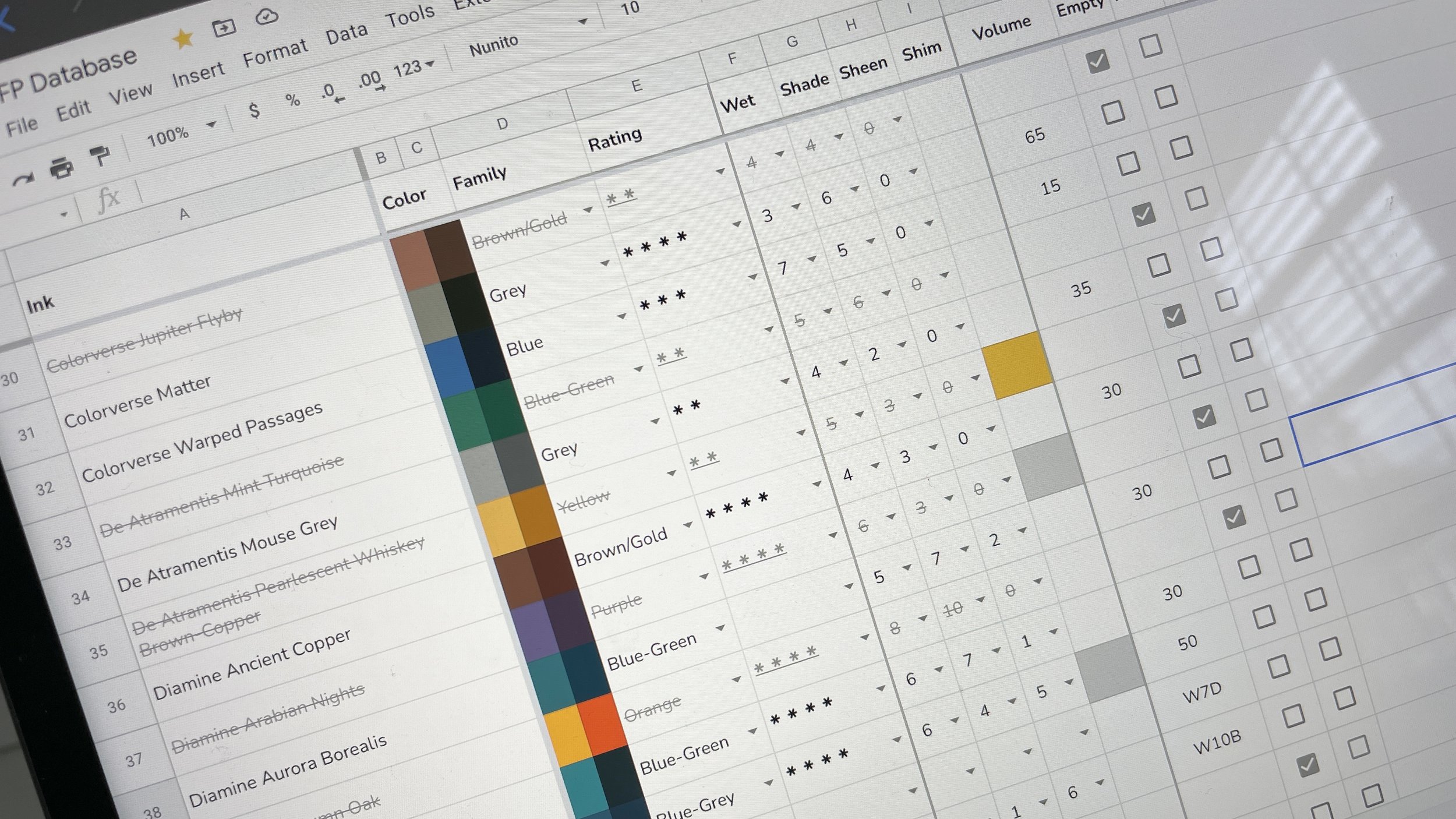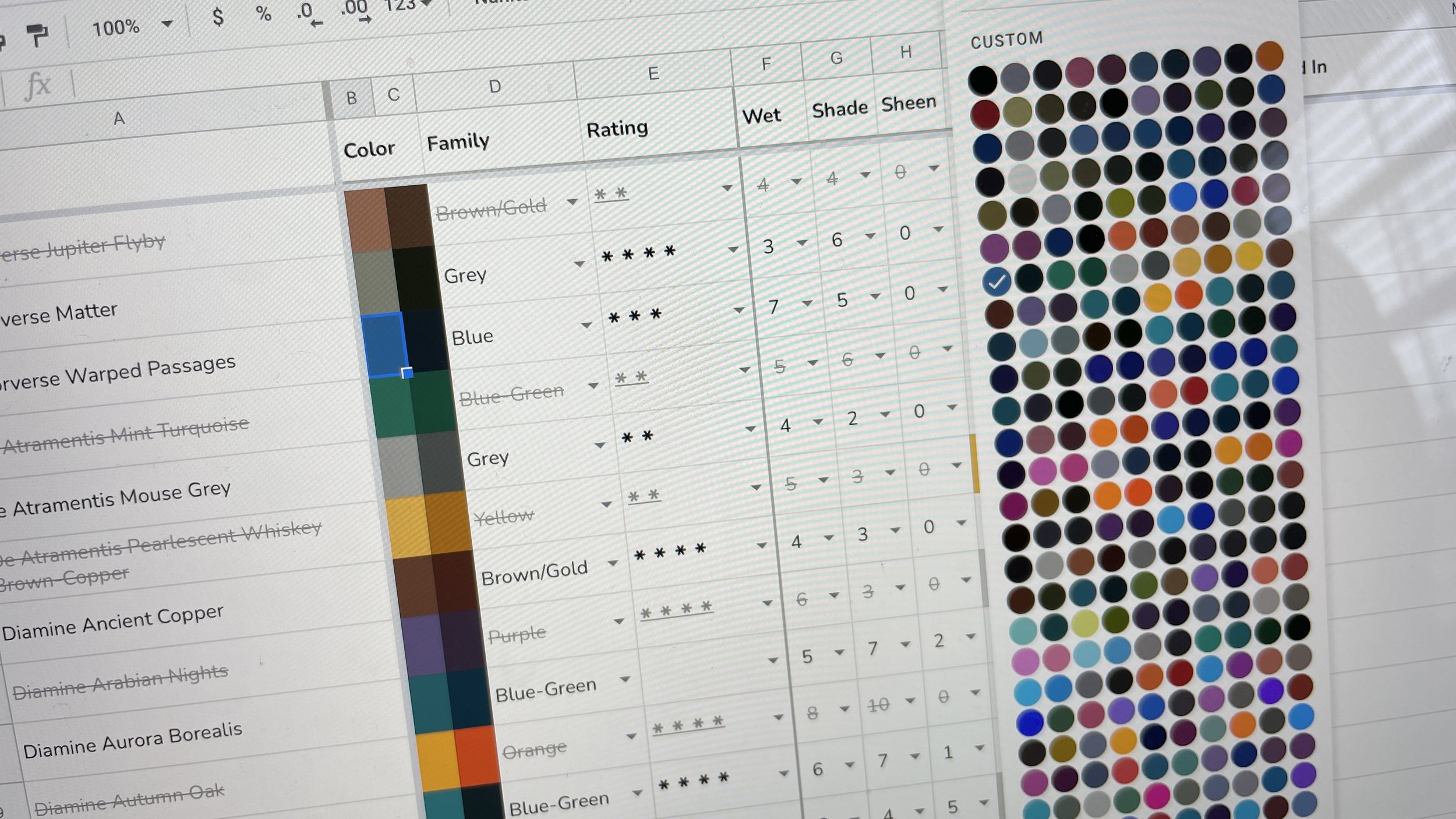In defense of the peculiarly particular stationery database
One of my favorite facets of the stationery hobby is how granular folks can get about storing, sorting and choosing what they write with. I dig getting lost in the weeds with the systems folks create and participate in. Exploring electronic systems like Fountain Pen Companion and David’s algorithm over at Too Many Pelikans inspired me to create my own databases.
One popular public option is Fountain Pen Companion. FPC offers an online database focused on comparing and sharing ink collections with other people. It has pre-built fields for saving — and searching — inks by name, complete with a digital color swatch. And a reliable search function, primarily by ink name. It brings folks together. Love it.
The algorithm David uses at Too Many Pelikans randomizes his pen, nib, and ink combinations. He records how each combination writes together on small cards, which he then scans and uploads to his blog. And randomized ink and nib pairings ensures his writing experiences remain exciting and new. David’s very particular use of programming (and math) reintroduces diversity to his writing each time he uses it.
My own database is focused on comparing inks’ characteristics to one another. And it creates space for recording which inks and pens are being used together. It doesn’t yet bring my ink and pen pairings into dialogue with one another in an archived way. But it does a great job of reliably rendering my writing options searchable — from all of my devices.
My database is both a log of my currently inked and an historical document. It offers a recording of which inks proved fun and which sparked frustration, or simply that “meh” feeling. And history — like bow ties — is cool.
Albeit a tad judgy
FPC’s swatch feature inspired me to build swatches into my own ink database: one for the lightest shade and a second for the darkest shade each ink shows off while writing. I take a picture of a writing sample and use the Digital Color Picker to find and copy the hex value for each. Then I color the cell block accordingly. Easy-peasy.
Lightest and darkest, front and center
I also enjoy recording ink qualities like wetness, sheen, and shimmer. I use drop down menus to rate the prominence of each ink’s wetness, shading and sheen. A recent addition is the colored cell that records shimmer color. Inks can be easily scanned and compared to one another. A useful resource for our current era of subtly different ink shades.
Taken together, the goal of my database is to create an archive of my thoughts on each ink I try. There is even an “empty” column to record bottles and samples which I’ve used up. When checked, the ink’s row greys out. Neat. Keeping an easily-scanned record of inks I’ve tried helps me to make more educated choices about future ink purchases. I’ll know what I have and have not found joy in using before.
Do I need to track each of these qualities? Not strictly. Tracking a gaggle of particularities for each ink and ink sample derives joy for me. Curating my collection helps me to hone in on the ink qualities I like — and how those preferences shift over time.
The popularity of very particular systems like these suggests many of us share an interest in exploring, sorting and sifting through our analog writers and inks. And lately, I’ve fielded quite a few questions from readers who want to explore databases like my pen collection and ink collection. So I pulled together a fully customizable Google Sheet template.
The ink collection template comes complete with an instructions guide. I’m leaning in on what makes an ink collection fun for me. And I hope that sharing the template proves similarly fun for you. Cheers.
This week’s Inked Tines update includes my most recent currently inked writing tools.
Toolset
Pens. The standout combo this week is, interestingly, my lowest-entry writer. A heavy wood and metal pen with a grippy section. This pair is elevated by Mike Masuyama’s divine fine cursive italic grind. The week’s daily driver for every task that didn’t involve a stencil. Meeting notes, reading notes, task management, lesson plans. Empty.
Nakaya Neostandard (B) — Empty. Made the brave choice to bring this combo to meetings — until Wednesday. The broad dusty green line was well-suited to accenting against this week’s two dark grey inks. Meeting notes, lesson plans, reading notes.
Franklin-Christoph 46 (EF SIG) — Feed. The medium width of the 46’s section and light weight made it well-suited to detailed marking and editing. My primary marking and revising pair. Also, used the EF line and popping red-brown as an easily-seen status marker. Trackers, paper marking, accent notes, accent reading notes, lesson plans.
TWSBI 580-ALR (M Predator) — 2/5 (from a 1/2 fill). Primary journaling pair. Shades prominently on Cosmo Air Light paper. Experimented as an accenting pen. Aonibi is too dark against dark grey. M reverse side of the grind worked great for pocket notes. Pocket notes, journaling, letter writing, meeting notes, lesson plans.
Parker Vacumatic (F) — 1/2. Surprisingly strong as a reverse writer. Dry enough to prevent smearing against my plastic stencil. My daily driver sidekick. Round nib worked well for quick writing, stencil work, and some pocket notes.
Kaweco Sport (EF) — 1/2. Saw only targeted use this week. The hard starts continue, making this a frustrating combo for pocket notes. Accenting meeting notes remains a fitting job for Fireopal. The orange is easily seen while scanning notes. Meeting notes, lesson plans, some pocket notes early in the week.
Notebooks. Work bujo. Musubi Cosmo Air Light 83 (A5). Another busy week of teaching produced 15 new pages in the work bullet journal. The notebook now stands at page 168 of 208.
Reviewing my average usage, I anticipate finishing this Musubi in another three weeks. Comforting to know I have a second Musubi waiting on the bookshelf in my study. Proper planning prevents last-minute notebook shopping.
My two-page weekly has settled since September. A tracker for my classes runs along the top of the weekly.
The rest of the pages are split into six sections. Five sections offer room for nine tasks each weekday. Nine is the most I’m able to complete in a given school day. The sixth is a “Later” category. Later houses new tasks that I won’t, or cannot, get to until a later week.
Later gator
The remainder of the week’s pages comprise six lesson plan outlines and six pages of meeting notes. The Nakaya’s dusty green is the accent in half of my meeting notes.
Life beyond matchy-matchy
Journal. Taroko Breeze (A5). I ran through one two-page journal entry on Wednesday evening. I started by grabbing the Nakaya. It was empty and still lounging in my penvelope. Uncapping was shortly followed by a few dry scratches and an audible “aww.”
Then I turned to the TWSBI for the entry itself. Mr. Bacas’ predator grind did well by me.
Beak
I navigated a bout of exhaustion early in the week. A result was early bedtimes through until Friday. Journaling happens in the evenings for me since school meetings start at 7:30 am. So the Taroko sat in my bag four of five days.
Looking back, I’m reminded of the importance of forgiving myself. While journaling was not abundant this week, I managed two pages.
Successful journaling, for me, isn’t about streaks. Or filled pages. Success is starting again. And I did just that on Wednesday. Phew.
Singing the siren song of my people
Pocket notebook. Stalogy Editor 1/2 Year (A6). Six new pages of pocket notes. I used the TWSBI and Parker for in situ notes. The Franklin-Christoph was an accenting combo that tracked my progress moving notes from the Stalogy into emails or my weekly task list.
Two pages are homework pacing charts. These are fun to build and incredibly useful. I used the Parker’s Azure Noir for the dates and the Franklin-Christoph’s Candy Marsala for tracking my progress.
Part of migrating into our new learning management system involves building out homework calendars from scratch. These charts visualize which days I will teach each lesson, and so help me plan due dates weeks beforehand.
Perks of a pocket notebook with pre-printed structure
Written dry. Three pens down this week. The Nakaya ran empty during a mid-week meeting Wednesday afternoon. The Jinhao survived through until Friday. My primary notetaker and task manager.
The Franklin-Christoph still writes, even though the converter is empty. Soon.
Empty pens = the “to clean” pile
Newly inked. I stuck to the week’s original currently inked. Despite a mid-week urge to replace the Nakaya. Pat on back earned.
The collection
Incoming / new orders. I came across a new-to-me online stationery shop, Desk Gems, this week. Pen folk on the Pen Addict Slack suggested the shop in a thread about vendors who carry exciting washi tapes.
Curiousity led me to order a handful of holiday gifts for my partner and one of Kokuyo’s new Perpanep notebooks. Quick shipping, responsible packaging, and a lovely handwritten note from the owner. Success.
Nooks and crannies
Outgoing / trades or sales. No movement outward this week.
Currently reading and listening
Fiction. I continued my reading of Herbert’s Dune Messiah this week. Another two chapters into the storyline. Events are moving slowly as Herbert continues to introduce us to the novel’s newest slate of characters. Interesting. Plodding, but interesting.
Nonfiction. I reviewed two phenomenal histories for chapters I can use in my LGBTQ Studies class next spring. My plan is to break the class into three “acts:” past, present, and futures.
John D’Emilio’s book is a groundbreaking history of the formation of orientation as a political demographic. Margot Canaday’s offers an easily accessible modern U.S. history of how the politics of immigration, the military, and welfare have shaped who counts as “American.”
I read both of these books years ago. Each is already annotated and highlighted. My review consisted of scanning annotations for crucial historical movement that students would benefit from investigating. The review focused on the first two chapters and conclusions of both texts: for 54 pages of re-reading.
I dig introductions for teaching. Authors tend to define their concepts and provide one or two easy-to-get-into examples in introduction chapters. Both Canaday and D’Emilio do just that. Success.
Music. A search for “piano only” in Spotify yielded a neat playlist called Atmospheric Piano.
The playlist sat in the background all week while I taught. The mellow tone suited our rainy, cool weather. Worth a listen if you’re looking for a soundtrack to support your rainy reading day.












